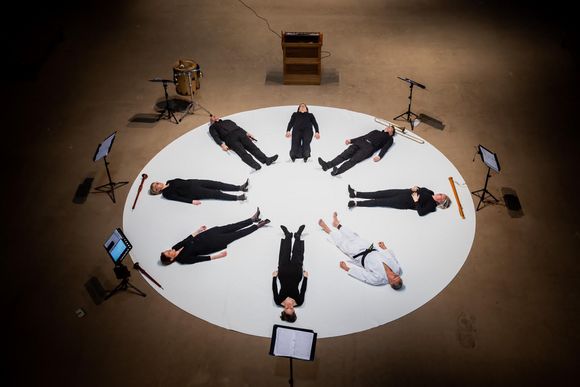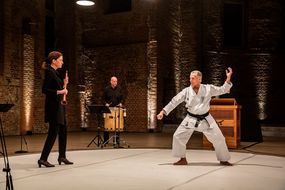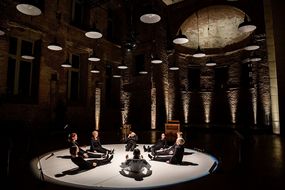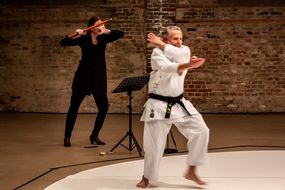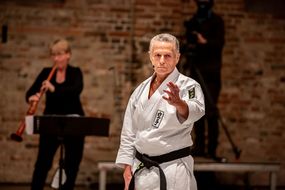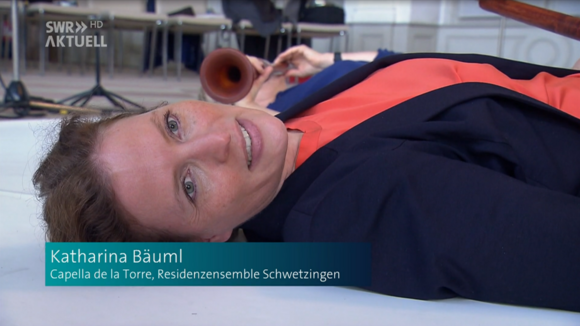Nobody had this idea before: to bring together Renaissance music and karate. It was only Capella de la Torre under the direction of Katharina Bäuml and the Italian karate teacher Maurizio Castrucci who discovered how well the two arts fit together.
But how did it happen?
Sleepless on the return journey from a Japan tour, Katharina Bäuml went to the tea kitchen of the long-haul plane late at night. There she met the Italian karateka Maurizio Castrucci - one of the great masters of his discipline, as it turned out. We started talking. During the exchange of experiences in Japan, the two found some agreement: Both in the East Asian martial arts tradition of karate Shōtōkan, especially in its fixed sequences of movements, the so-called katas, as well as in the sacred music of the Renaissance, it is about highly ritualized arts, who deal with the basic experiences of human existence. Here as there, the aim of the exercise is "to perfect the soul", as it is called in the "Dōjōkun", the rules for training martial arts.
...und wie beides verbunden wird!
Wir haben uns in den letzten Jahren die Frage gestellt, wie wir als Menschen von heute noch die polyphone Musik der Renaissance verstehen können.
Vor 500 Jahren waren die Gegebenheiten nämlich noch anders: Man hörte Polyphonie auf der Basis gregorianischer Gesänge im Kirchenjahr, die jedem Gläubigen bekannt waren. Die Musik stand im direkten Kontext zu einem sakralen Bau, sie war oft Teil des Gottesdienstes und an starke Rituale gebunden.
Ebenso starke Rituale sind Teil der Kampfkunst Martial Arts, dem Karate Shotokan Stil, im besonderen von Kata. Durch das Zusammenspiel der beiden Künste entsteht eine weitere Dimension; Polyphonie und Karate behalten dabei ihre Wurzeln und sind auch je einzeln für sich verständlich.
Deshalb haben wir neue Konzertprojekte entwickelt, in denen wir z.B. ein Mess-Ordinarium von Josquin Desprez (1450-1521) – seine Missa Pange Lingua – mit Gregorianik und drei verschiedenen Kata kombiniert haben, die sowohl in Stille als auch in Teilen zur Musik ausgeführt werden.
Verbindendes Element ist dabei vor allem der Fluss des Atems, der sowohl in den Kampfkünsten als auch in der Musik, besonders für die Blasinstrumente von Capella de la Torre, eine entscheidende Rolle spielt. Andererseits ist es der Rhythmus: Mal verbindet er die einzelnen Schichten in der Regelmäßigkeit eines Herzschlages, mal als unvorhergesehener Ausbruch einer neuen Dimension. Rituale und das sorgsam überlieferte Wissen von Jahrhunderten erscheinen so in ganz aktuellem Licht, ohne den jeweiligen Kontext zu verlieren.
What do renaissance polyphony and martial arts have in common?
In terms of content, it is the belief in the power of the universe and the idea of absorbing and bundling this power; formally it is the monastic life (or its today's equivalent), which is the basis for the largely liturgically determined music of the Renaissance as well as for the practice of the martial arts. Together with the Italian karate teacher Maurizio Castrucci, the Capella takes the audience on a journey to the center of strength and concentration. In our concerts, the boundaries between participants and audience become fluid - in the combination of silence, polyphony, and kata (stylized ritual fighting form of karate Shotokan). This creates new spaces: by changing neither karate nor renaissance music, astonishing new perspectives arise that lead back to the general basic questions of being human - rhythm and flow of breath.
The way to the performance ...
Tireless rehearsals, immense discipline and a large portion of humility are the prerequisites for a practice that not only meets the highest demands in terms of craftsmanship, but should also reveal the spiritual dimensions of the rituals practiced. In the 500-year-old vocal polyphony from Central Europe as well as in the art of movement that emerged on Okinawa in the 19th century, breath, heartbeat and rhythm in general are the connecting elements. This is how the idea for this unique, experimental project in the most beautiful sense of the word came about. East and West, visual and acoustic events, martial arts and Christian piety enter into an exciting dialogue without losing their cultural independence and fascinating foreignness. Sometimes the musicians react in concert to the katas of the black belt wearer in spontaneous improvisation. But above everything lies the silence of perfect concentration ...
